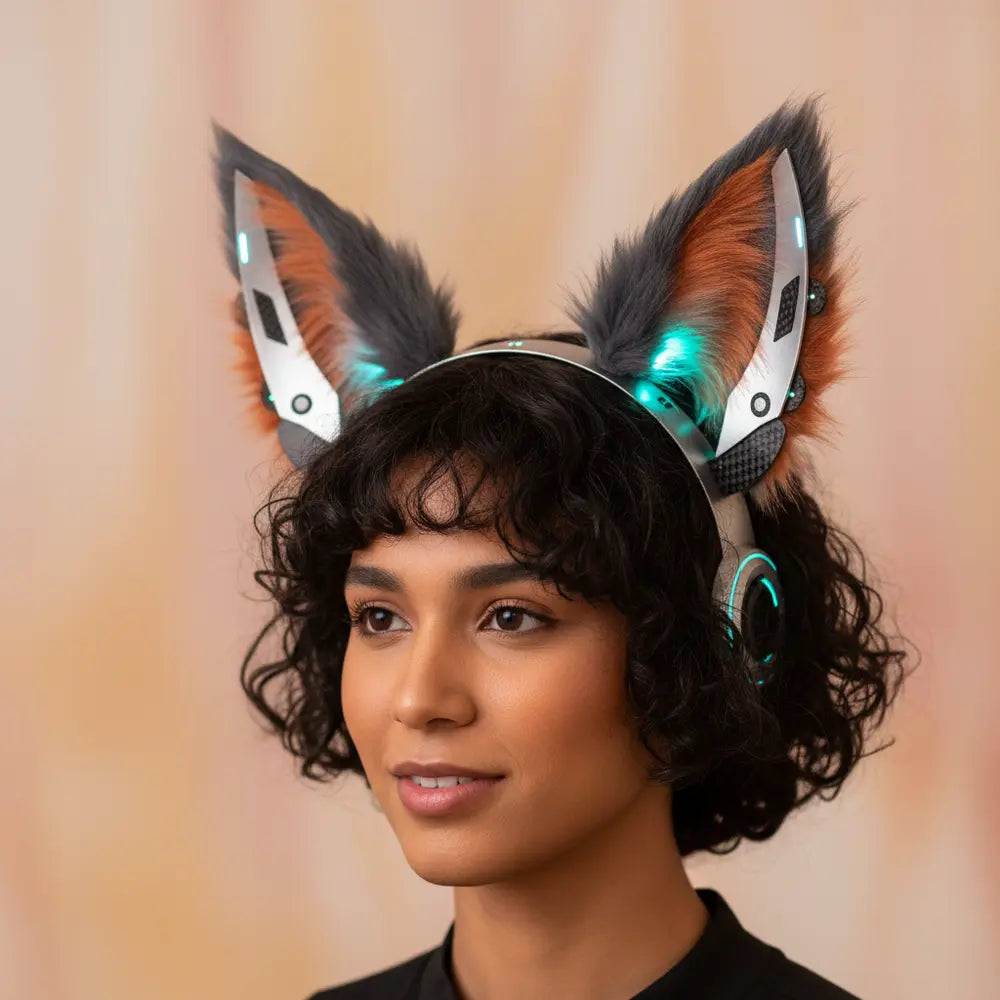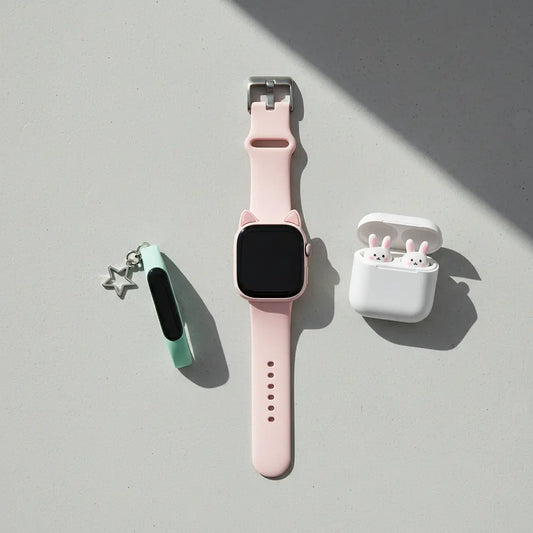
Why Twitching Ears Headbands Are 2025’s Cosplay Tech Trend
It started with a six-second clip from Anime Expo 2025 that exploded across TikTok. A cosplayer, perfectly portraying Anya Forger, turns her head with a look of mild surprise. Just as her expression shifts, the fluffy pink anime cosplay headband with realistic ears atop her head twitches independently, once, then twice. The crowd’s audible gasp gives way to a roar of delight. The video hits a million views in hours.
That single moment captured a major shift. Suddenly, everyone is asking: why have twitching ears headbands become the must-have piece of wearable tech cosplay? These aren’t just static props anymore. They are expressive, robotic accessories that move and react, often using sophisticated sensors or even brainwave-reading technology.
This article isn’t just a review of the latest cosplay gadgets. We’re exploring the cultural phenomenon, decoding the technology, and analyzing how this trend is reshaping the intersection of fashion and robotics. Get ready to understand why a pair of moving ears is the definitive symbol of cosplay’s high-tech future.
What Are Twitching Ears Headbands?
Ever see a cosplayer with ears that move on their own and wonder, "What exactly *is* that?" This section breaks down the core concept and explains why this simple-sounding gadget has become so captivating.
A twitching ears headband is an accessory that features a pair of animatronic ears, typically styled after animals like cats, foxes, or wolves. Unlike static, plush ears, these robotic versions move, twitch, and swivel in response to various inputs. This brings a dynamic, life-like quality to a cosplay that was previously impossible to achieve.
The earliest popular versions, like the groundbreaking Necomimi, used simple brainwave sensors to react to the wearer's mental state. Modern versions have expanded on this, using everything from motion sensors to direct manual controls. The appeal is rooted in the core goal of cosplay: embodying a character fully. These headbands add a layer of non-verbal expression that feels incredibly authentic.
For the cosplay community, it’s a game-changer. Imagine a stoic wolf character whose ears subtly flatten when they're angry, or a cheerful cat-girl whose ears perk up with excitement. This technology allows cosplayers to convey emotion and personality with a simple, intuitive accessory, bridging the gap between a 2D drawing and a 3D performance.
The Cultural Significance: From Kawaii Fashion to Tech-Driven Cosplay
Curious why this trend is more than just a tech gimmick? We’ll explore the deep cultural roots that connect kawaii aesthetics, anime fandom, and the drive for ultimate cosplay authenticity.
The popularity of a moving cat ear headband with sensors is no accident. It’s the result of a perfect storm of cultural forces. The concept of *nekomimi*, or cat ears, has been a staple in Japanese anime and manga for decades, symbolizing everything from cuteness and innocence to mischievousness and agility. They are a core part of the *kawaii* (cute) aesthetic.
Movement elevates this aesthetic to a new level. In cosplay, authenticity is currency. A cosplayer who can perfectly replicate a character's outfit is respected, but one who can embody their mannerisms and expressions is revered. Twitching ears offer a powerful tool for this embodiment. They react, they express, they make the character feel *alive*.
This trend also has roots in Japanese fashion subcultures like those seen in Harajuku, where blending technology with clothing has long been a form of self-expression. Wearable tech isn’t just a utility; it’s a fashion statement. As a result, these headbands are crossing over from convention floors to everyday wearable anime fashion, seen in TikTok videos and street style photos.
How Do Twitching Ears Headbands Work? The Tech Behind the Trend
Ever feel like the technology behind these ears is pure magic? This section pulls back the curtain to explain the different types of sensors, power sources, and engineering that make the twitching possible.
The "magic" of a twitching ears headband comes down to some surprisingly accessible technology. The mechanism that drives the movement is usually a set of small servo motors hidden in the base of each ear. The real innovation lies in what *triggers* those motors. There are two primary methods used in most models on the market today.
Motion & Manual Control
The most common and affordable twitching ears headband under $50 often uses simple technology. Some rely on an accelerometer, which detects the wearer's head movements. A sudden nod or tilt might trigger a pre-programmed twitch. Others come with a small, concealable remote or a button on the headband, giving the cosplayer full manual control for choreographed performances or photoshoots.
Brainwave Sensors (EEG)
This is where the tech gets truly fascinating. A brainwave cat ears headband explained is a marvel of consumer-grade neuroscience. These high-end models use a small, dry EEG (electroencephalogram) sensor that rests on the forehead. This sensor measures the faint electrical signals produced by your brain, distinguishing between states of high focus and deep relaxation.
When you concentrate, the ears might perk up and swivel forward. When you relax, they might droop and relax. It creates an almost telepathic link between your mood and the accessory. While not reading specific thoughts, this feedback loop creates a powerful illusion of the ears being a natural extension of your body. If you are intrigued by the science behind this reactive technology, our comprehensive guide "From Cute to Clever: What Are Moving Cat Ears?" offers an in-depth look.
No matter the control method, battery life is a crucial consideration for any cosplayer. Most modern headbands use a rechargeable lithium-ion battery, often charged via USB-C. A good quality headband should offer 6-8 hours of continuous use, enough to last through a full day at a convention.
Best Twitching Ears Headbands for Cosplay 2025
Feeling ready to get your own pair but overwhelmed by the options? This guide breaks down the best choices for every budget and need, helping you find the perfect wearable tech cosplay accessory.
Choosing the right twitching ears headband depends on your budget, your cosplay needs, and how much control you want. The market in 2025 has options ranging from simple, fun gadgets to sophisticated, expressive tech.
Affordable Options: Under $50
For cosplayers on a budget or looking for a fun accessory for Halloween, there are many great choices. These models typically use motion sensors or manual controls. While they don't offer the reactive "magic" of brainwave tech, they are reliable and perfect for photoshoots where you want to pose the ears in a specific way.
- Pros: Very affordable, easy to use, great for beginners.
- Cons: Movement is pre-programmed or manual, not reactive to mood.
- Pro-Tip: Look for models with swappable ear covers to match different characters with a single headband base.
High-End Models: Brainwave & Advanced Sensors
For the ultimate in expressive cosplay, brainwave-sensing ears are the gold standard. These models offer the most realistic and immersive experience, as the ears seem to move with your actual emotions. They are a significant investment but provide a level of character embodiment that is unmatched.
When selecting a premium product, the consensus among cosplayers is that a model like the Dynamic Moving Fluffy Cat Ears for Expressive Cosplay offers a fantastic balance of features. It provides reliable, expressive movement and a comfortable design, making it a top choice for serious enthusiasts. This headband is a great example of a product that combines realistic aesthetics with user-friendly technology.
Where to Buy & Price Comparison
You can buy twitching ears headband online from various sources. Etsy is a hub for custom and handmade versions, while Amazon offers a wide range of commercial models. For high-end or specialized ears, going directly to the brand's website is often the best choice.
To help you decide, here is a quick comparison of what to expect:
| Feature Category | Budget Models (Under $50) | High-End Models ($100+) |
|---|---|---|
| Sensor Type | Manual Control / Motion | EEG Brainwave / Advanced |
| Movement | Pre-programmed Twitches | Reactive & Dynamic |
| Battery Life | 4-6 Hours | 8-10+ Hours |
| Customization | Often Limited | High (Swappable Covers) |
| Best For | Beginners, Halloween, Photos | Serious Cosplay, Streaming |
Which twitching ear style do you prefer?
Influencer & Convention Spotlight: Case Studies
Want to see how this trend is actually playing out in the real world? This section highlights the key influencers and viral convention moments that launched twitching ears into the cosplay stratosphere.
The rise of the twitching ears headband wasn't just a market trend; it was a cultural movement fueled by creators and fans. Social media, particularly TikTok, became the primary stage for showcasing this new form of tech cosplay accessories.
One of the biggest drivers has been cosplay influencer @KitsuneKraft, whose "Day in the Life of a Fox Spirit" series went viral. Her videos use a high-end robotic cat ears headband (modded to look like fox ears) to express a range of emotions—curiosity as she explores a garden, frustration when her toast burns, and excitement when a package arrives. Her fans aren't just complimenting her costume; they're reacting to the *character's* perceived emotions.
That moment the ears twitch on their own... 🤯 #CosplayTech #AnyaForger #AnimeExpo
"The ears moving on their own sold it!!!" - Fan Comment
The viral moment at Anime Expo 2025 was another turning point. The clip of the Anya Forger cosplayer wasn't just popular; it was analyzed. Fans created reaction duets and slowed-down edits, marveling at how the ear twitch perfectly matched the character's signature "Heh" expression. Fan comments flooded the video: "That's it. That's the most canon cosplay I've ever seen." and "The ears moving on their own sold it!!!"
These case studies reveal a crucial insight: the technology is successful because it serves the story. It’s not about the gadget itself, but about how the gadget enhances character and performance. It allows for a deeper connection between the cosplayer, the character, and the audience.
DIY and Alternatives: Creating or Customizing Your Own
Feeling creative and have a tighter budget? This section is for the crafty cosplayer, offering a look into the world of DIY moving ears and other clever alternatives.
While the market for twitching ears headbands is growing, the spirit of cosplay has always included a strong DIY ethic. For tech-savvy creators, building your own moving ears is a rewarding project that offers ultimate customization.
A typical DIY build involves a few core components:
- A microcontroller: An Arduino Nano or a similar small board acts as the "brain."
- Servos: Tiny motors that create the twitching motion.
- A power source: Usually a small, rechargeable LiPo battery.
- The structure: A sturdy headband, wire, and a 3D-printed or hand-sculpted base for the ears.
This path requires some basic knowledge of electronics and coding, but the online maker community is full of tutorials. A key pro-tip for DIY builders is to use a separate, pocket-sized USB power bank connected by a thin wire. This allows for a much longer battery life than a small onboard battery can provide, perfect for long convention days.
If a full DIY build feels too complex, there are other great alternatives. Many artisans on Etsy create posable ears with a wire framework inside. While they don't move on their own, you can bend them into different expressive shapes for photos. Another popular option is modding a commercial pair of realistic cosplay ears by adding piercings, airbrushing details, or even embedding tiny LEDs for a cool glowing effect.
Your Cosplay Tech Checklist
The Future of Wearable Tech Cosplay Gadgets
Wondering what comes after twitching ears? Let's look ahead to the next wave of innovation where cosplay, fashion, and robotics are set to merge in even more exciting ways.
The twitching ears headband is not an endpoint; it's a doorway. It has proven there's a huge appetite for expressive, interactive cosplay gadgets. The innovations we're seeing in 2025 are just the beginning, and the future of wearable tech cosplay is incredibly bright.
Experts predict the next evolution will involve more complex movements and integrations. Imagine a moving cat ear headband with sensors that can not only twitch but also flatten, rotate 360 degrees, and even change color based on bio-feedback. We may see programmable tails that wag with excitement or bristle with alarm, all controlled by the same discreet sensors.
The most exciting frontier is the integration with Augmented Reality (AR). Picture a cosplayer at a 2026 convention wearing a brainwave headband. When they focus, it not only moves their physical ears but also triggers a magical aura or elemental effect visible to everyone else through their AR glasses or smartphone cameras. This would merge the physical costume with digital effects in real-time.
Ultimately, we are witnessing robotics transition from a purely functional field into a core component of fashion and self-expression. The line between costume and technology is dissolving. Future cosplay won't just be about what you wear, but about how your attire interacts with you and the world around you. To truly master the technology available today and prepare for tomorrow, the ultimate guide is our deep dive on "How Twitching Cat Ear Headbands Work in 2025".
More Than a Gadget: An Expression
The rise of the twitching ears headband is about so much more than a cool piece of technology. It represents a fundamental desire in the cosplay community for deeper authenticity and a more profound connection with the characters they love. It’s the perfect fusion of *kawaii* culture’s expressive heart and the innovative power of wearable tech.
This trend has proven that accessories can be more than static props; they can be extensions of our performance and personality. Whether you opt for a high-end brainwave model, a budget-friendly manual version, or decide to build your own, you are participating in the future of fashion.
Ready to find your perfect pair or learn more about this trend? Explore our complete product guides and stay ahead of the curve. To get the latest insights on cosplay tech delivered straight to your inbox, subscribe to our newsletter for exclusive analysis and trend reports.
Join the Wearable Tech Revolution
Subscribe to our newsletter for the latest on cosplay tech, trend reports, and exclusive offers.
SUBSCRIBE NOWFrequently Asked Questions (FAQ)
1. Are twitching ears headbands comfortable to wear all day at a con?
Most commercial models are designed with comfort in mind, using lightweight materials and padded headbands. High-end models especially prioritize a balanced, comfortable fit for all-day wear. However, weight and fit can vary, so it's wise to read reviews focusing on long-term comfort.
2. How accurate are the brainwave sensors in moving cat ear headbands?
The consumer-grade EEG sensors are surprisingly effective at distinguishing between general states of mental focus and relaxation. They won't read your specific thoughts, but they create a very convincing and reactive experience. Accuracy can be affected by placement on the forehead and external "noise," but modern algorithms have made them quite reliable for expressive cosplay.
3. Can I find an affordable twitching ears headband under $50 that actually works?
Yes, absolutely. Headbands in this price range typically use motion sensors or manual button controls instead of brainwave tech. They work very well for creating pre-set movements or for photoshoots, offering a reliable and fun experience without the higher cost of EEG models.
4. Is it hard to make your own DIY moving cosplay ears?
It can be challenging if you're a complete beginner with electronics. The project requires basic knowledge of soldering, coding with a platform like Arduino, and wiring small motors (servos). However, there are many detailed video and written tutorials online that can guide you step-by-step, making it an accessible project for a dedicated hobbyist.
5. Do these headbands work with any hairstyle or with wigs?
Most headbands are designed to be worn over your natural hair or a wig. The fit is similar to any standard fashion headband. For brainwave-sensing models, the forehead sensor needs to make clean contact with your skin, so you may need to style your bangs or wig fringe to the side to ensure it works correctly.




